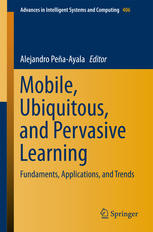

Most ebook files are in PDF format, so you can easily read them using various software such as Foxit Reader or directly on the Google Chrome browser.
Some ebook files are released by publishers in other formats such as .awz, .mobi, .epub, .fb2, etc. You may need to install specific software to read these formats on mobile/PC, such as Calibre.
Please read the tutorial at this link: https://ebookbell.com/faq
We offer FREE conversion to the popular formats you request; however, this may take some time. Therefore, right after payment, please email us, and we will try to provide the service as quickly as possible.
For some exceptional file formats or broken links (if any), please refrain from opening any disputes. Instead, email us first, and we will try to assist within a maximum of 6 hours.
EbookBell Team

0.0
0 reviewsThis book is concerned with the mobile, ubiquitous, and pervasive learning arena. It present a collection of works corresponding to four categories: reviews, studies, conceptual proposals, and approaches. As a result of the submission and revision processes eight manuscripts were accepted and organized into the aforementioned four parts as follows:
·Review: a couple of chapters offer a survey of related works. One concerns with the diversity of mobile, ubiquitous, and pervasive labor, where interested findings are unveiled based on correlations. Other focuses on adaptive and adaptable architectures that are suitable to implement ubiquitous learning sceneries, whose contribution represents a model of a domain specific architecture.
·Studies: two chapters explore issues related to the effect of question styles made through smartphones and tablets, and the disposition of teachers to exploit mobile devices at classroom.
·Conceptual: a pair of chapters offer a given proposal, the first to develop adaptive mobile learning systems by means of a framework based on contextual information; and the second with the purpose to share some guidelines of how to apply cloud computing in the development and operation of mobile.
·Approaches: two chapters apply a specific paradigm as part of a whole application and reveal the achieved impact. One of them uses augmented reality to encourage children to learn about trees as context-sensitive informal learning. The other, immerses children in playing a learning game to learn math by cooperating between members team and interacting through mobile devices.
This volume will be a source of interest for researchers, practitioners, professors, and postgraduate students aimed at updating their knowledge and finding targets for future work in the mobile, ubiquitous, and pervasive learning field!